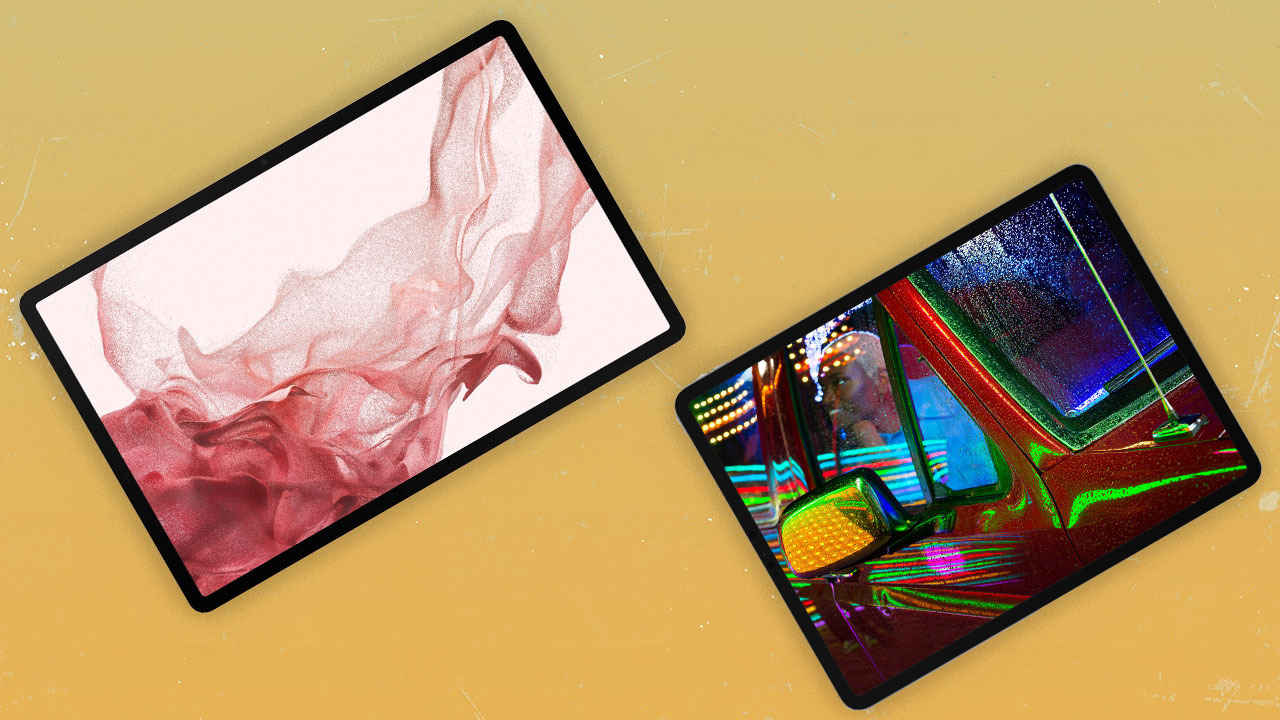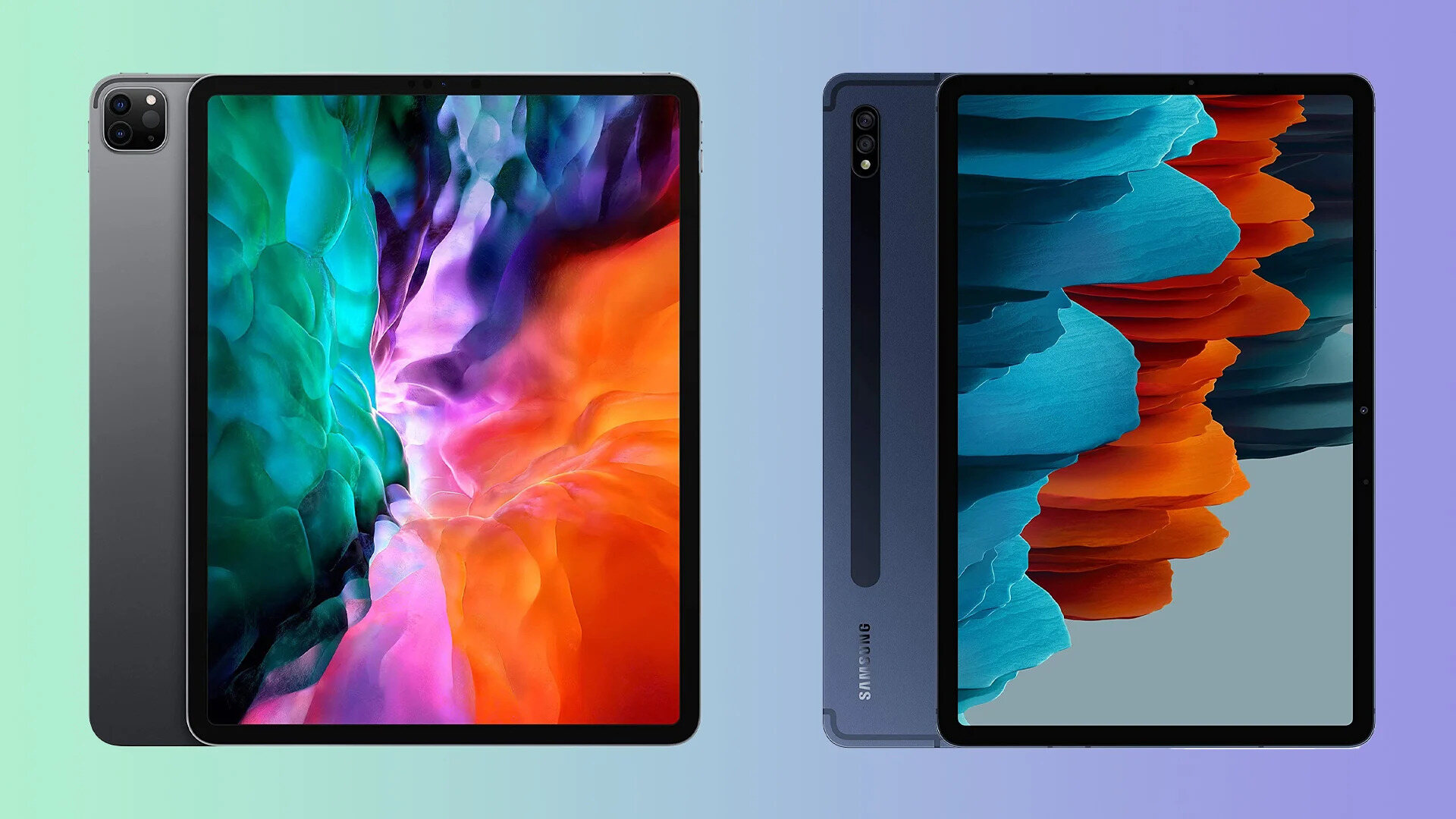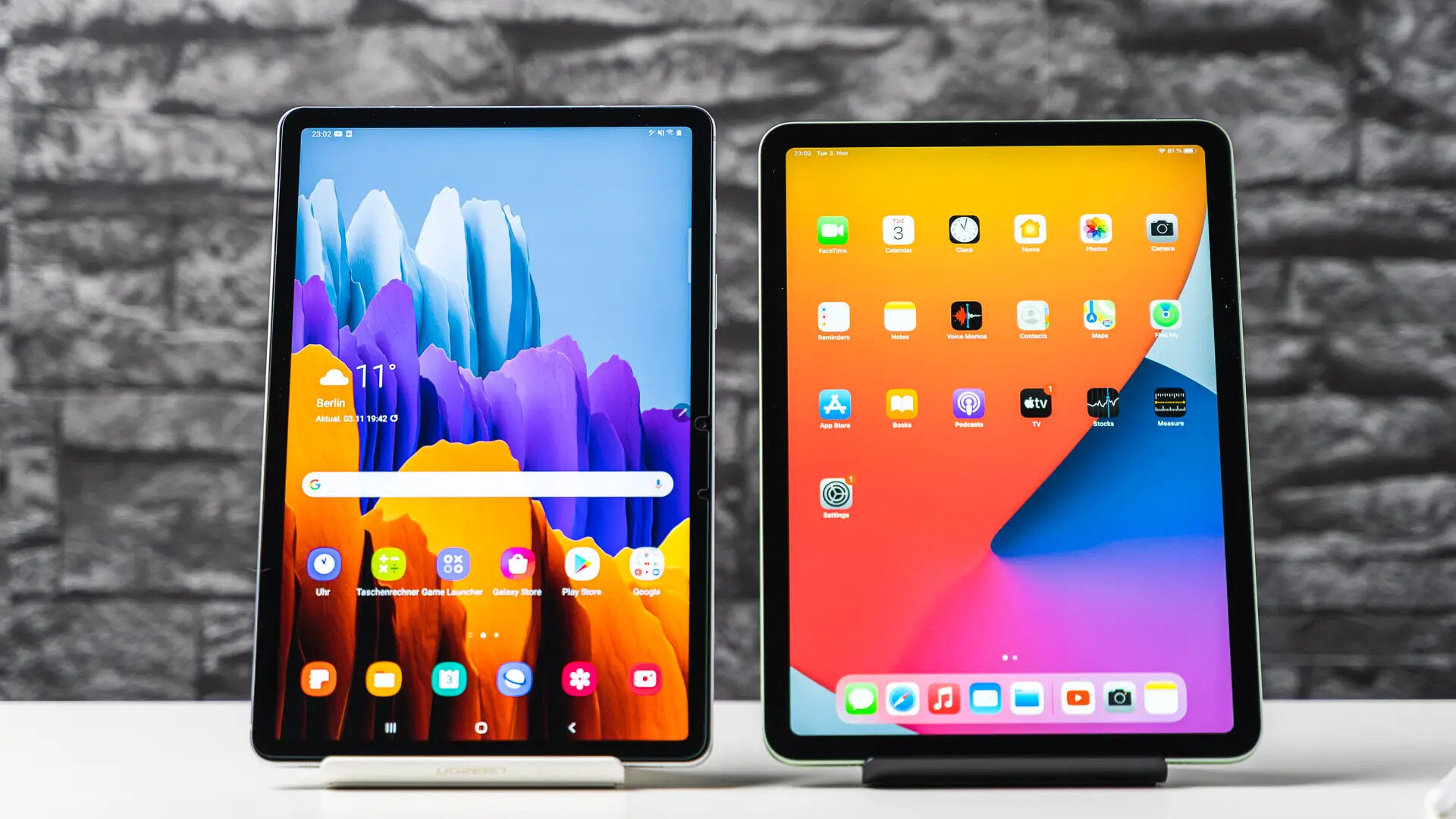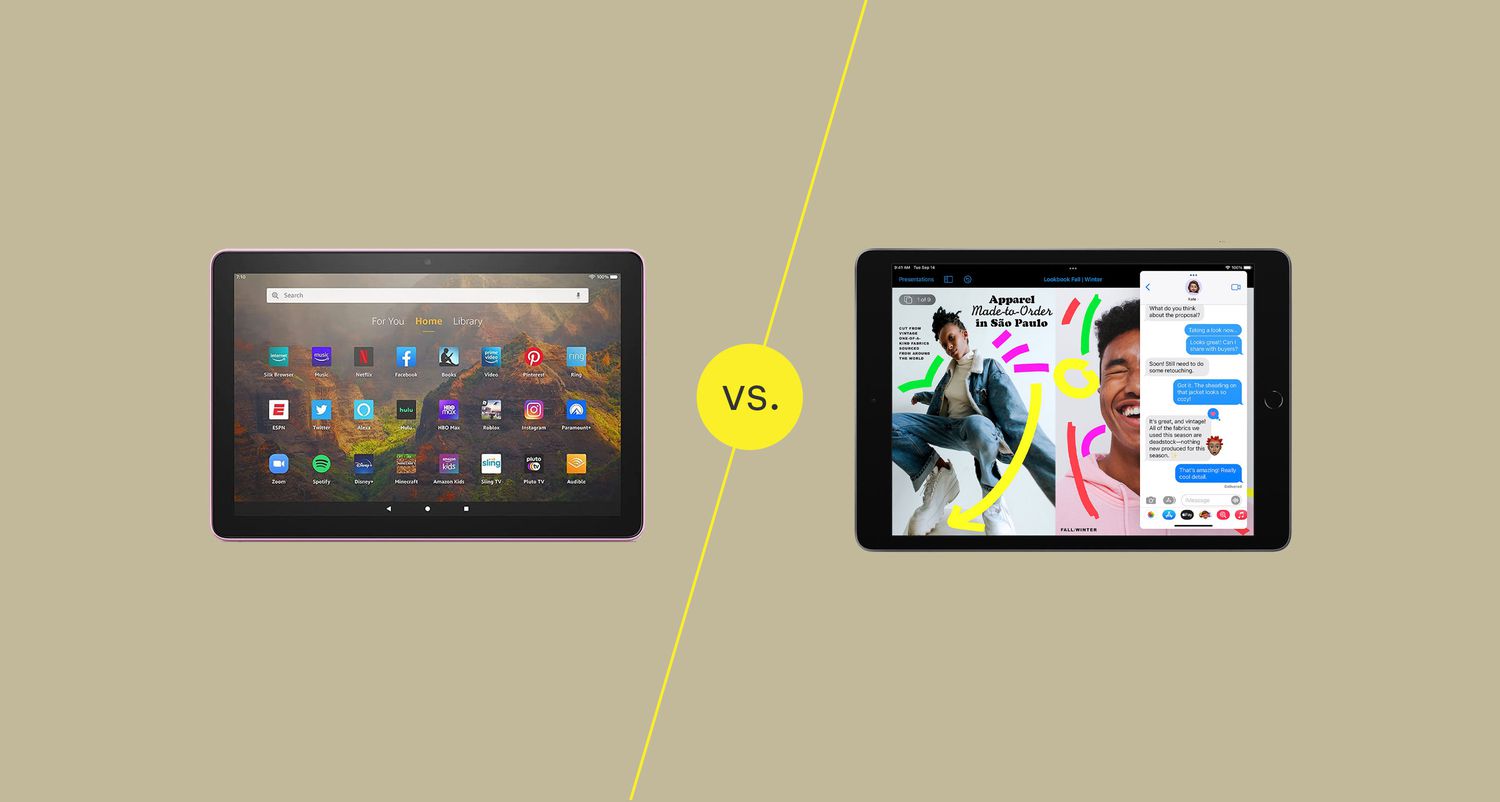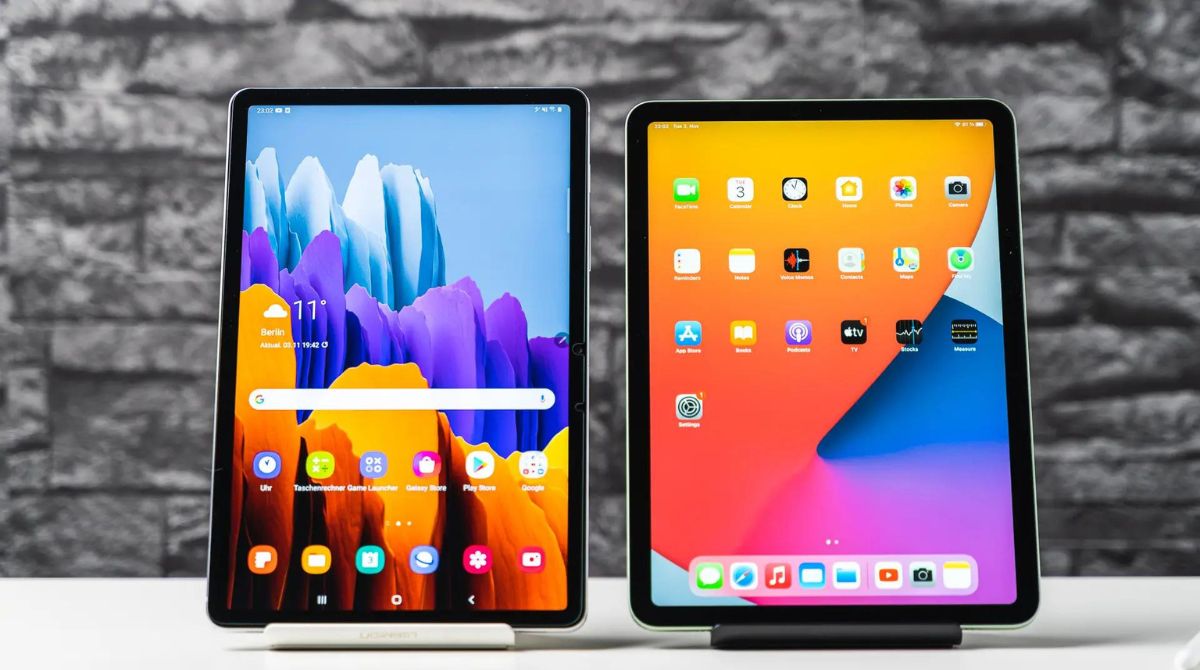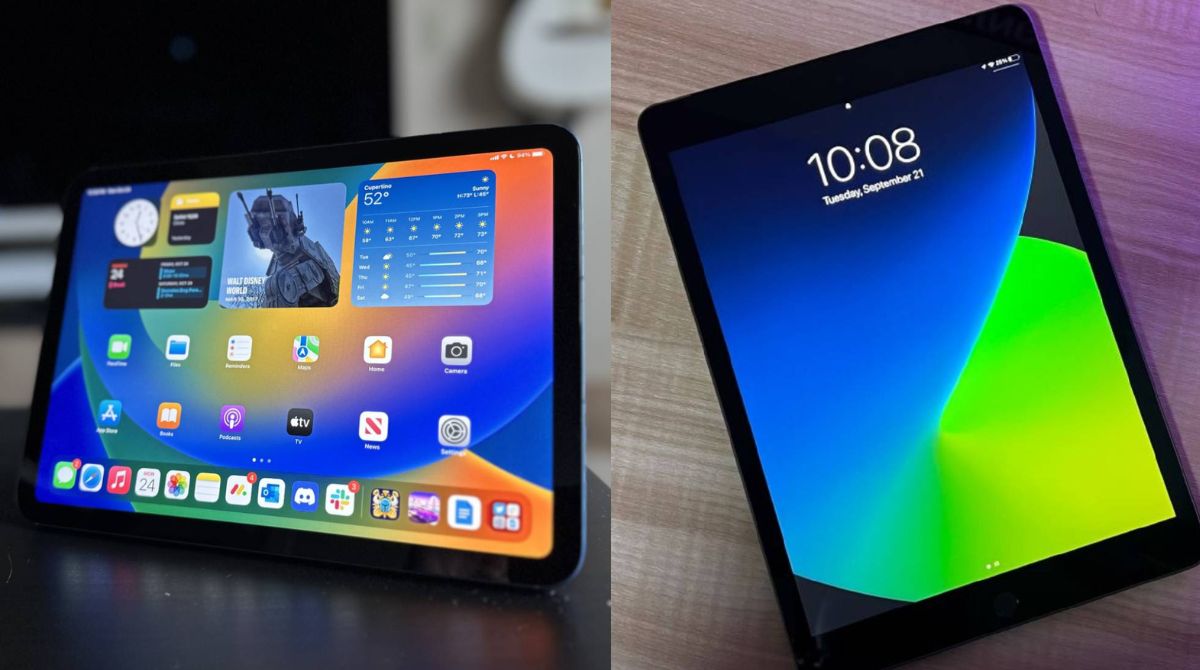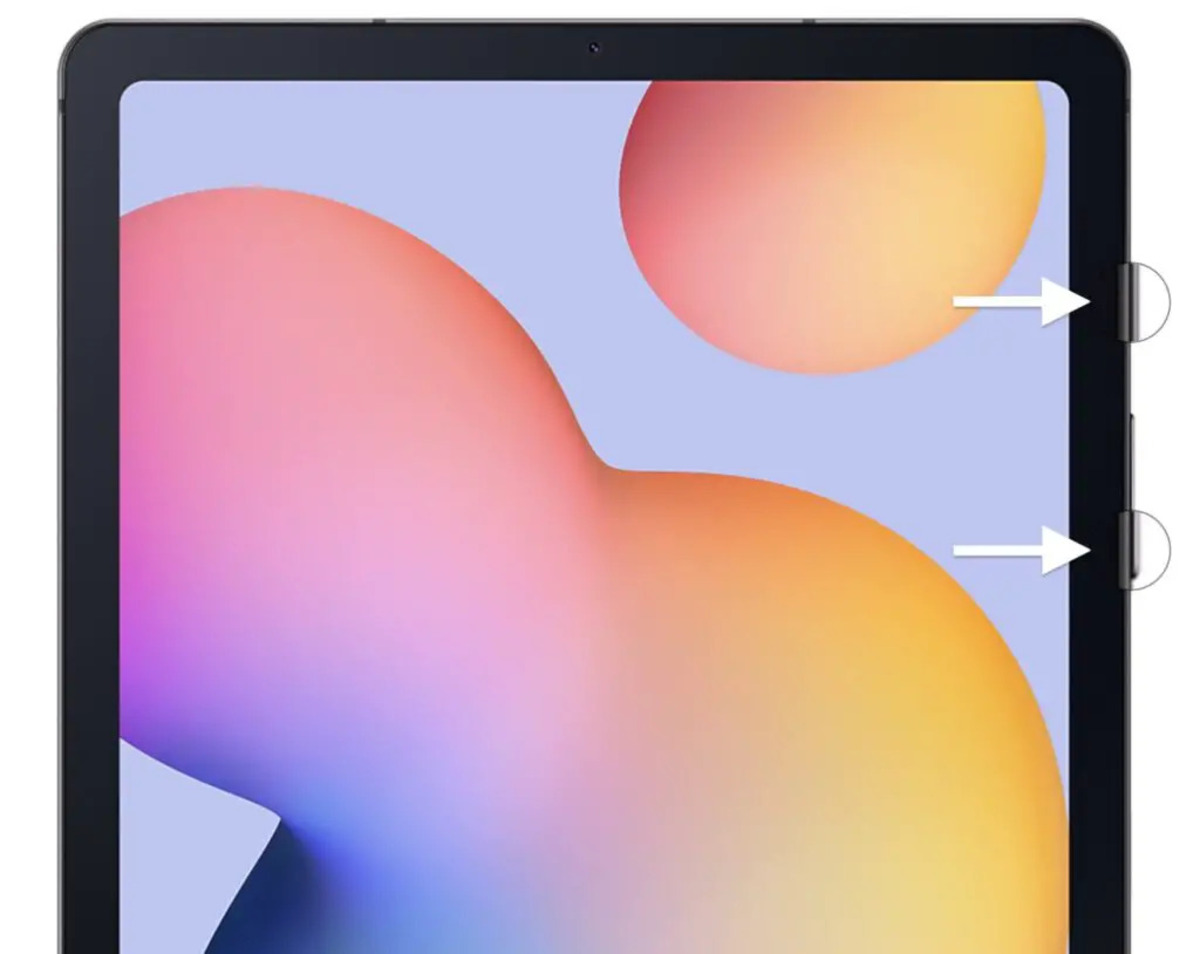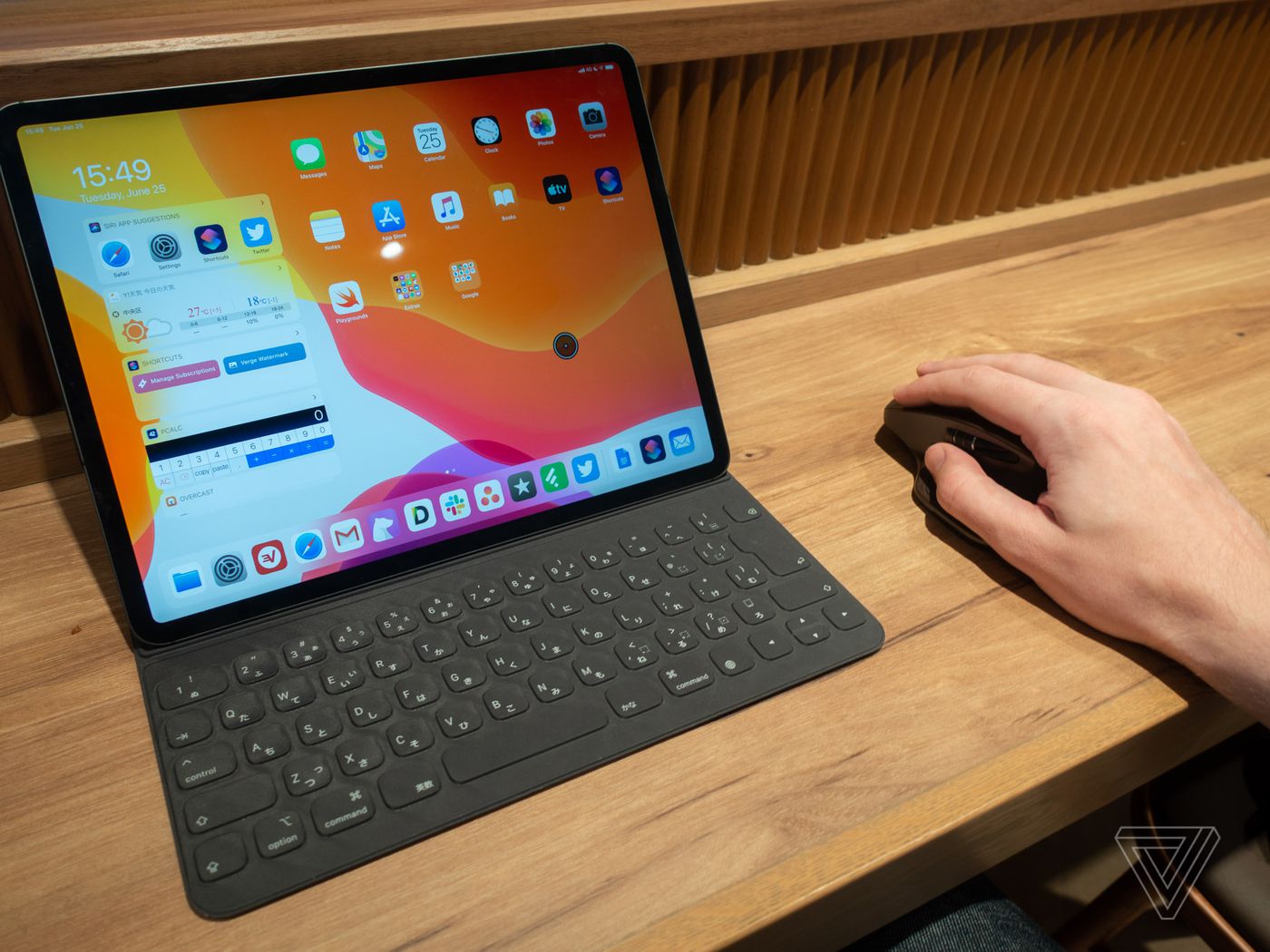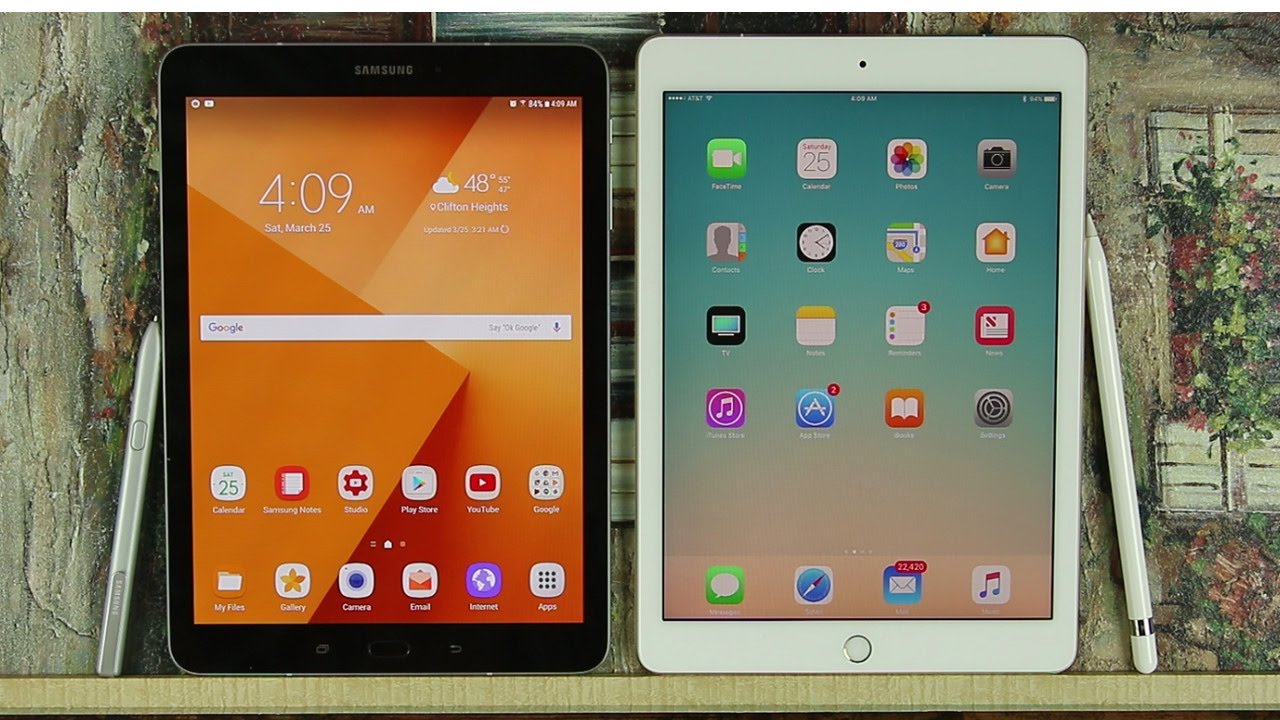Introduction
When it comes to choosing a portable device for everyday tasks, tablets and iPads have become the go-to options for many. These sleek and lightweight devices have revolutionized the way we consume digital content, stay connected, and get work done on the go. But with so many options available in the market, it can be challenging to decide between a tablet and an iPad.
In this article, we will delve into the differences and similarities between tablets and iPads to help you make an informed decision. We will explore various aspects such as design, operating system, performance, storage, display quality, battery life, connectivity options, productivity, and pricing. By the end, you will have a clearer picture of which device suits your needs and preferences.
Tablets, in general, are portable computing devices that offer the convenience of a mobile phone with a larger screen size. They are available in various sizes, ranging from 7 to 12 inches, and run on operating systems such as Android, Windows, or iOS. On the other hand, iPads are Apple’s line of tablets that run solely on the iOS operating system.
Both tablets and iPads offer a host of features and functionalities that cater to different user requirements. Whether you are a student, professional, or casual user, understanding the key distinctions between these devices is essential in making an informed choice. So, let’s dive deeper into the design, performance, display, connectivity, and other critical factors to determine which device is better suited for you.
Design and Portability
When it comes to design and portability, both tablets and iPads offer sleek and lightweight options that are easy to carry and handle. Tablets generally come in a variety of sizes, ranging from compact 7-inch models to larger 12-inch devices. iPads, on the other hand, have a more standardized size range, with options like the iPad Mini, iPad Air, and iPad Pro.
In terms of build quality, iPads are known for their premium look and feel. They feature a seamless aluminum or glass body that exudes elegance and durability. Tablets, on the other hand, come in a range of materials and finishes, from plastic to metal, catering to different price points and preferences.
When it comes to portability, tablets have the advantage of being available in smaller sizes, making them more compact and lightweight. This makes them easier to carry in bags or even hold with one hand. iPads, although slightly larger, are still highly portable and can be comfortably carried around.
In terms of ergonomics, iPads often have a more refined design with slim bezels and a more streamlined form factor. This allows for a more immersive viewing experience and a comfortable grip. Tablets, on the other hand, may have larger bezels, which can affect the overall aesthetics and sometimes make one-handed usage slightly more challenging.
Another aspect to consider is the presence of physical buttons and ports. iPads typically have a minimalistic design, with just a few buttons and a lightning connector for charging and data transfer. Tablets, depending on the brand and model, may have more physical buttons, such as volume controls and power buttons, as well as additional ports such as USB, HDMI, or SD card slots. These extra features can be beneficial in certain use cases, such as connecting external storage devices or projectors.
In summary, both tablets and iPads offer sleek and portable designs. iPads have a more refined and premium feel, while tablets come in a range of materials and finishes. Tablets excel in their compact size and lightweight nature, making them ideal for on-the-go use. iPads, although slightly larger, are still highly portable and offer a more immersive viewing experience. Whether you prioritize portability or specific physical features will depend on your personal preferences and usage requirements.
Operating System and User Interface
One of the key differences between tablets and iPads lies in the operating system and user interface. Tablets run on various operating systems such as Android, Windows, or iOS, while iPads exclusively run on Apple’s iOS.
Android tablets offer a more customizable user experience, with a wide range of options for interface customization and home screen personalization. Users have the ability to customize widgets, choose from a variety of app launchers, and tweak settings according to their preferences. Tablets running Windows allow users to take advantage of the familiar desktop-like interface, making them suitable for users who require full productivity and multitasking capabilities.
On the other hand, iPads have a user-friendly and intuitive interface, optimized specifically for Apple’s iOS. The interface is known for its simplicity and ease of use, making it accessible even for first-time users. iPads benefit from a seamless integration with other Apple devices, allowing for seamless synchronization and easy sharing across platforms. The iOS ecosystem also offers a vast selection of high-quality apps optimized for iPad, ensuring a smooth and consistent user experience.
Both tablets and iPads offer app stores where users can download various applications and games. However, the selection of apps is often more extensive in the Apple App Store, with many developers prioritizing optimizing their apps for iPads specifically. This means that iPad users have access to a larger library of apps that are tailored to take full advantage of the device’s capabilities.
When it comes to software updates and security, iPads have the advantage of receiving regular and timely updates directly from Apple. These updates not only bring new features but also include important security patches to keep your device safe. While some tablets do receive updates, the frequency and longevity of support can vary depending on the manufacturer and operating system.
In summary, tablets offer a more customizable user experience with a range of operating systems to choose from, including Android and Windows. However, iPads provide a user-friendly interface, seamless integration with other Apple devices, and access to a vast library of optimized apps through the Apple App Store. The choice between a tablet and an iPad in terms of operating system and user interface ultimately comes down to personal preference, ease of use, and the specific apps and features you require.
Performance and Processing Power
When it comes to performance and processing power, both tablets and iPads have evolved significantly over the years. However, there are some notable differences to consider.
The performance of a tablet or an iPad is primarily influenced by the processor or chipset it uses. Tablets often offer a range of processor options from different manufacturers, such as Qualcomm, MediaTek, or Intel. iPads, on the other hand, feature Apple’s custom-designed processors, which are known for their impressive performance and efficiency.
In general, iPads tend to outperform most tablets in terms of raw processing power and smoothness of operation. This is largely due to the optimized hardware-software integration that Apple offers, allowing the operating system and apps to run seamlessly on the device. iPads also tend to have higher RAM capacities, which further enhances their multitasking capabilities and overall performance.
That being said, tablets running on Android or Windows can still offer excellent performance, especially in models equipped with higher-end processors and ample RAM. These devices can handle everyday tasks, including web browsing, document editing, and media consumption, without any significant issues. However, they may not match the level of performance and optimization seen in iPads.
It’s worth noting that both tablets and iPads come in different variants, with varying levels of processing power and storage capacity. More powerful configurations are usually available at a higher price point, so consider your usage requirements and budget when making a decision.
In terms of gaming performance, iPads often provide a superior experience due to their dedicated graphics processing units (GPUs) and optimized software. The iOS ecosystem also tends to receive early access to high-end gaming titles and exclusive game releases.
In summary, iPads generally offer superior performance and processing power compared to tablets, thanks to their optimized hardware-software integration and custom-designed processors. However, tablets running on Android or Windows can still provide satisfactory performance for everyday tasks, especially in higher-end models. Consider your specific usage requirements, budget, and the level of performance you need before making a decision.
Storage and Expandability
When it comes to storage, both tablets and iPads offer a range of options to accommodate different storage needs. However, there are some differences to consider in terms of storage capacity and expandability.
Tablets typically offer a range of storage options, starting from 16GB and going up to 256GB or even higher. Some Android tablets also come with the option to expand the storage further using a microSD card, allowing users to add more storage space as needed. This can be particularly useful if you have a large media library or frequently download and store files.
iPads, on the other hand, have a more limited range of storage options and do not offer expandable storage through external memory cards. The available storage capacities usually start at 32GB and go up to 1TB in the higher-end iPad Pro models. It’s important to carefully consider your storage needs and budget when choosing an iPad, as the initial storage capacity cannot be expanded later on.
It’s worth noting that both tablets and iPads have the option to store files and data in the cloud. This allows for seamless access to your files across multiple devices and offers an additional backup solution for your important data. Services such as Google Drive, iCloud, or Microsoft OneDrive provide cloud storage options that can be synced with your tablet or iPad.
When choosing between a tablet and an iPad, consider your usage requirements and the amount of storage you anticipate needing. Tablets with expandable storage options may be more suitable if you have a large media collection or if you frequently work with large files. On the other hand, if you prefer a more streamlined and integrated ecosystem, iPads with their fixed storage capacities may be sufficient for your needs.
In summary, both tablets and iPads offer a range of storage options, but tablets typically have more flexibility in terms of expandability through microSD cards. iPads, on the other hand, have a more limited range of storage options and do not offer expandable storage. Consider your storage needs and the ability to expand storage when making a decision between a tablet and an iPad.
Display and Visual Quality
The display and visual quality of a device play a significant role in the overall user experience. When comparing tablets and iPads, there are a few factors to consider, including screen size, resolution, and display technology.
Tablets come in various screen sizes, typically ranging from 7 to 12 inches. The size you choose will depend on your preference and how you plan to use the device. Larger screens are generally better for media consumption, productivity tasks, and gaming, while smaller screens offer portability and are ideal for reading or casual browsing.
Resolution is another important aspect to consider. Both tablets and iPads offer high-resolution displays, with some models even featuring Quad HD or 4K resolution. Higher resolution screens provide sharper and more detailed visuals, resulting in a more immersive viewing experience. However, it’s important to note that the human eye may not always be able to distinguish the difference in resolution beyond a certain point, so the resolution requirement may vary based on individual preferences.
In terms of display technology, iPads often utilize Apple’s Retina display technology, which offers vibrant colors, excellent contrast, and sharp image quality. This technology ensures that text and graphics appear crisp and clear, enhancing the overall visual experience. Tablets, on the other hand, may use different display technologies, such as LCD or AMOLED, depending on the brand and model. These technologies also provide good visual quality, but the specific characteristics may vary across different devices.
It’s important to consider factors such as color accuracy, color saturation, and viewing angles when comparing the display quality of tablets and iPads. iPads, with their Retina display technology, typically excel in these areas, ensuring accurate and vibrant colors from various viewing angles. Tablets may offer comparable display quality, but some models may not have the same level of color accuracy or viewing angles as iPads.
In summary, both tablets and iPads offer high-quality displays, but iPads, with their Retina display technology, often provide a more immersive and visually appealing experience. However, tablets can also offer excellent display quality, and the specific characteristics may vary depending on the brand and model. When choosing between a tablet and an iPad, consider the screen size, resolution, and display technology that best suit your usage requirements and preferences.
Battery Life
Battery life is a crucial consideration when choosing a portable device, as it determines how long you can use it before needing to recharge. When comparing tablets and iPads, there are several factors that can influence battery life, including device specifications and usage patterns.
In general, iPads are known for their excellent battery life, thanks to the optimized hardware and software integration provided by Apple. The combination of efficient processors, operating system optimization, and intelligent power management allows iPads to deliver long-lasting battery performance. Depending on the model and usage, iPads can typically provide battery life ranging from 8 to 12 hours, making them ideal for on-the-go productivity or entertainment.
Tablets, on the other hand, offer a wider range of battery life depending on their specifications and usage patterns. Some tablets may deliver comparable battery life to iPads, while others may have shorter battery life due to less efficient processors or less optimized software. It’s important to check the manufacturer’s specifications and read reviews to get an idea of the expected battery life of a particular tablet model.
It is worth mentioning that battery life can vary greatly depending on how the device is used. Factors such as screen brightness, active applications, internet connectivity, and media playback can all impact battery drain. It’s important to understand your typical usage patterns and adjust settings accordingly to maximize battery life.
In addition, it’s worth noting that iPads often come with fast charging capabilities that allow you to recharge the device quickly. This can be especially beneficial when you’re in a hurry and need to top up the battery before heading out.
When considering battery life, it’s essential to balance your usage requirements with the device’s battery performance. If you rely heavily on your device for long hours of work or entertainment without easy access to charging, an iPad with its reputable battery life may be the better choice. However, if you have a specific tablet model in mind and are aware of its battery limitations, you can adjust your usage accordingly or consider investing in portable power banks for extended battery life.
In summary, iPads generally provide excellent battery life, thanks to their efficient hardware-software integration and optimized power management. Tablets offer a wider range of battery life depending on their specifications and usage patterns. It’s important to consider your usage requirements and adjust settings accordingly to maximize battery life, regardless of whether you choose a tablet or an iPad.
Connectivity Options
When it comes to connectivity options, both tablets and iPads offer a range of features to keep you connected and facilitate data transfer. Let’s explore some of the key connectivity options to consider when choosing between a tablet and an iPad.
Both tablets and iPads typically come with Wi-Fi connectivity, allowing you to connect to wireless networks for internet access. This is essential for browsing the web, streaming media, and downloading apps and updates. Most devices support the latest Wi-Fi standards, ensuring fast and reliable connections.
In addition to Wi-Fi, tablets and iPads generally offer models with built-in cellular connectivity, such as 4G LTE or 5G. This allows you to access the internet even when there is no Wi-Fi network available. Cellular connectivity is particularly useful for users who are frequently on the go or need internet access in areas where Wi-Fi coverage is limited.
When it comes to data transfer, tablets often come equipped with a variety of ports and slots. These can include USB ports, HDMI ports, and SD card slots, allowing you to connect various external devices or expand storage. This makes tablets more versatile and suitable for users who require connectivity with a broader range of peripheral devices.
iPads, on the other hand, offer a more streamlined approach to connectivity. They typically come with a lightning connector, which is used for charging the device and connecting to accessories. Some newer models of iPads also support USB-C, which offers faster data transfer speeds and more versatility in terms of accessory compatibility. However, it’s worth noting that the USB-C port on iPads may have limitations compared to traditional USB ports found on tablets.
Both tablets and iPads also support Bluetooth connectivity, allowing you to connect wireless peripherals such as keyboards, mice, speakers, or headphones. Bluetooth connectivity provides a convenient way to expand the functionality of your device without the need for cables or dongles.
When choosing between a tablet and an iPad, consider your connectivity needs and the specific ports and options offered by each device. If you require a wide range of ports and expandability, tablets may be the better choice. However, if you prefer a more streamlined and integrated ecosystem, iPads offer a seamless and straightforward connectivity experience.
In summary, both tablets and iPads offer Wi-Fi connectivity, ensuring internet access in a wide range of settings. Tablets often provide more ports and expansion options, while iPads offer a more streamlined connectivity experience with their lightning or USB-C connectors. Consider your connectivity needs and the specific accessories or devices you plan to connect to make the best choice for your requirements.
Productivity and Multitasking
When it comes to productivity and multitasking capabilities, both tablets and iPads have made significant advancements in recent years. Let’s explore how these devices can enhance your productivity and handle multitasking scenarios.
Tablets running on operating systems like Android or Windows often provide a more traditional desktop-like interface and offer a range of productivity features. These devices allow you to install and use a variety of productivity apps, including word processors, spreadsheets, presentation software, and note-taking apps. Additionally, tablets may offer support for external peripherals such as keyboards, mice, or stylus pens, further enhancing productivity and creating a desktop-like experience.
iPads, with their proprietary iOS operating system, have also become powerful productivity tools. Apple has made significant strides in optimizing the iPad and developing a range of productivity-focused apps. The iPad’s large screen, coupled with the availability of accessories like the Apple Pencil and Smart Keyboard, makes it ideal for tasks such as content creation, note-taking, and multitasking.
Multitasking capabilities have improved on both tablets and iPads. Tablets powered by Android or Windows often offer a split-screen view, allowing you to have multiple apps open and visible at the same time. This lets you work on two apps simultaneously, enhancing productivity and efficiency.
iPads have a unique multitasking system called Split View, which lets you work on two apps side by side. You can also use Slide Over to quickly access and interact with a third app without fully interrupting your current workflow. This multitasking functionality, combined with the smooth and responsive performance of iPads, makes them highly capable productivity machines.
Some tablets and iPads also offer features like handwriting recognition and advanced note-taking capabilities, which can be invaluable for students, professionals, and creatives alike. These features allow you to take handwritten notes, annotate documents, and draw diagrams or sketches with precision.
In terms of file organization and document management, both tablets and iPads provide various options. Cloud storage services like Google Drive, iCloud, or Microsoft OneDrive allow you to store and access your files across devices seamlessly. Additionally, both tablets and iPads support third-party productivity apps like Microsoft Office or Google Workspace, enabling you to create, edit, and collaborate on documents, spreadsheets, and presentations.
When considering productivity and multitasking capabilities, it’s important to assess your specific needs and workflows. Tablets running on Android or Windows may offer more flexibility and compatibility with a wider range of software and peripherals, while iPads provide a more streamlined and integrated experience within the Apple ecosystem. Consider the apps, accessories, and tasks you frequently use and evaluate which device caters best to your productivity requirements.
In summary, both tablets and iPads have evolved into versatile productivity tools. Tablets running on Android or Windows offer a more traditional desktop-like experience, while iPads provide a streamlined and integrated ecosystem for productivity. Both devices have improved multitasking capabilities, allowing you to work on multiple apps simultaneously. Consider your specific productivity needs, preferred operating system, and app availability when deciding between a tablet and an iPad for productivity and multitasking.
Apps and App Store
The availability and quality of apps can greatly impact the overall functionality and user experience of a device. Both tablets and iPads offer access to an extensive selection of apps, but there are some differences to consider when it comes to the app ecosystem.
The Google Play Store is the primary app store for Android tablets, offering a vast collection of apps across various categories. From productivity tools and entertainment apps to games and social media platforms, there is a wide range of options to choose from. The Google Play Store provides a diverse app ecosystem, with a large number of both free and paid apps available for download.
Windows tablets, on the other hand, have access to the Microsoft Store, which offers a selection of apps tailored for the Windows platform. While the Microsoft Store may not match the sheer quantity of apps available on the Google Play Store or Apple App Store, it does provide a variety of productivity apps and tools that are optimized for Windows devices.
iPads have the advantage of the Apple App Store, which is known for its extensive library of high-quality apps. The App Store offers a rich ecosystem of apps specifically designed for iPad, taking full advantage of its hardware capabilities and available screen real estate. The App Store provides a curated selection of apps that have gone through Apple’s strict review process, ensuring a higher level of quality and security.
Many developers prioritize developing and optimizing their apps for iOS devices, including iPads. As a result, iPad users often have access to a wider variety of apps that are designed specifically for the device, providing a more seamless and user-friendly experience. Whether you’re looking for apps for productivity, creative tasks, education, or entertainment, the Apple App Store offers a comprehensive range of options.
It’s worth noting that while the Apple App Store may offer a vast selection of apps, it does come with some limitations. Apple enforces strict guidelines on app development and submission, resulting in a more controlled and curated app ecosystem. While this ensures a higher level of quality and security, it may limit the availability of certain apps or restrict the customization options for users compared to the more open platforms of Android and Windows tablets.
In summary, both tablets and iPads offer access to a variety of apps through their respective app stores. Android tablets have the Google Play Store, which offers a diverse range of apps, while Windows tablets have the Microsoft Store, which provides apps optimized for the Windows platform. However, iPads have the distinct advantage of the Apple App Store, which offers a wide selection of high-quality apps specifically designed for iPad, ensuring a seamless and user-friendly experience. Consider your specific app needs and preferences when choosing between a tablet and an iPad.
Price and Value for Money
When considering a tablet or an iPad, price is an important factor to evaluate. Both devices come in a range of price points, and determining the value for money depends on a variety of factors such as features, performance, brand reputation, and long-term support.
Tablets running on Android or Windows operating systems generally offer a wider range of price options, catering to different budgets. Entry-level tablets can be more affordable, making them suitable for casual use, media consumption, and basic productivity tasks. On the other hand, higher-end tablets that boast powerful processors, spacious storage, and additional features come with a higher price tag, appealing to users with more demanding requirements.
iPads, being Apple’s flagship tablets, are generally positioned in the higher price range. This is partly due to the premium build quality, powerful hardware, and software optimization that come with Apple devices. However, iPads also provide a high level of customer satisfaction, long-term support, and access to an extensive collection of high-quality apps, which contribute to their value for money.
In terms of long-term value, both tablets and iPads receive software updates to enhance features, fix bugs, and improve security. However, iPads typically receive longer software support from Apple compared to most Android or Windows tablets. Apple provides updates for several years, ensuring that your device remains compatible with the latest apps and features. This can be a significant factor to consider, as it contributes to the longevity and overall value of your investment.
It’s important to evaluate the features and specifications that matter most to you when considering the price and value of a tablet or an iPad. Assess your specific requirements and determine whether the device offers the necessary performance, storage, display quality, connectivity options, and software support to meet your needs. Additionally, consider the reputation and track record of the manufacturer or brand, as this can also influence the perceived value for money.
Finally, it’s worth considering the overall cost of ownership, including any additional accessories or peripherals you may need. Both tablets and iPads can benefit from accessories like keyboards, stylus pens, screen protectors, or protective cases, which may add to the overall cost.
In summary, tablets and iPads come in a range of price points, each offering different features, specifications, and levels of long-term support. Tablets running on Android or Windows operating systems cater to various budgets and offer a diverse range of options. iPads, on the other hand, generally come at a higher price but provide a premium build quality, powerful performance, extensive app selections, and longer software support. Consider your specific requirements, desired features, and budget to determine the best value for money when choosing between a tablet and an iPad.
Conclusion
In conclusion, choosing between a tablet and an iPad depends on a variety of factors including design preferences, operating system requirements, performance needs, storage capacity, display quality, connectivity options, productivity features, app availability, and budget considerations. Both tablets and iPads offer unique advantages and cater to different user preferences and usage scenarios.
Tablets, running on operating systems such as Android or Windows, provide a more customizable experience, a wider range of price points, and greater flexibility in terms of expandable storage and connectivity options. They are suitable for users who prioritize customization, compatibility with various peripherals, and a larger ecosystem of apps.
On the other hand, iPads, powered by Apple’s iOS, offer a seamless and user-friendly experience with a refined design, optimized performance, access to a wide range of high-quality apps through the Apple App Store, and longer software support. They excel in areas such as display quality, battery life, and overall productivity capabilities, making them well-suited for users looking for a premium and integrated ecosystem.
Ultimately, the choice between a tablet and an iPad boils down to your specific needs, preferences, and budget. Consider the key factors discussed in this article, evaluate your usage requirements, and prioritize the features that matter most to you. It is also highly recommended to test the devices in person and explore user reviews to gain a better understanding of the user experience before making a decision.
Whether you choose a tablet or an iPad, both devices have evolved significantly over the years and offer a wide range of capabilities to enhance your digital experience, boost productivity, and keep you connected on the go. Take your time, weigh the pros and cons, and choose the device that aligns best with your lifestyle, work, and entertainment needs.







